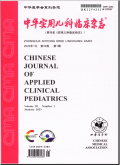摘要目的 探讨儿童肝豆状核变性(WD)的多系统症状特点及其头颅磁共振成像( MRI)表现.方法回顾性分析北京大学第一医院儿科2001年1月至2017年12月住院的65例肝豆状核变性患儿的临床资料.结果 65例患儿中神经型28例,非神经型37 例.神经型平均起病年龄为11. 0 岁,非神经型为8. 1 岁( t=3. 328,P=0. 001).76. 9%的患儿存在2个及以上系统受累,以肝脏、脑最常见,肾脏及血液系统受累不少见(分别为55. 4%和33. 8% ).存在K-F环、铜蓝蛋白及24 h尿铜三者中,17. 2%的患儿其中有2项正常,13. 8%的患儿其中有1项正常.神经型患儿K-F环阳性检出率为100. 0% ,非神经型患儿K-F环阳性检出率57. 6% ,二者比较差异有统计学意义(χ2 =13. 981,P<0. 001).K-F环阳性患儿年龄为(11. 8 ± 2. 7)岁,阴性患儿年龄为(7. 6 ± 3. 7)岁,二者差异有统计学意义(t=4. 221,P<0. 001).神经型和非神经型患儿24 h尿铜水平比较差异无统计学意义(t=0. 024,P=0. 981).神经型患儿最常见的神经系统症状包括构音障碍、震颤、流涎/吞咽/咀嚼困难、姿势异常等.头颅MRI示基底核、白质受累、脑萎缩、脑室增宽等表现在神经型及非神经型WD儿童中均可见到,其中基底核是最常见的受累部位,但丘脑及脑干受累仅见于神经型.在30例头颅MRI异常的患儿中,基底核、脑室增宽、脑萎缩、白质受累最早出现的年龄为8岁,而丘脑和脑干受累最早出现的年龄为12岁.神经系统症状出现时间越长,则丘脑及脑干越容易受累.结论 儿童肝豆状核变性多表现为多系统受累,其临床表现多样.K-F环、铜蓝蛋白及24 h尿铜三者中1项或者2项正常不能除外WD.头颅MRI异常可早于神经系统症状,基底核最常见、最早受累,丘脑及脑干较晚累及,多见于青春期.
更多相关知识
abstractsObjective To discuss the multiple system involvement and cranial magnetic resonance imaging (MRI)manifestations of Wilson disease(WD)in children. Methods This study was conducted on hospitalized chil-dren who were diagnosed as WD at the Department of Pediatrics,Peking University First Hospital during January 2001 to December 2017,and their clinical data were reviewed. Results Sixty-five children were enrolled,among whom 28 cases were of neurological type,while 37 cases were of non-neurological type. The average onset age of neurological type was 11. 0 years old,while non-neurological type was 8. 1 years old(t=3. 328,P=0. 001). Seventy-six point nine percent children had at least 2 systems involved,among which the liver and the brain were the most commonly in-volved,while the involvement in the urinary and the blood systems were not scarce(55. 4% and 33. 8% ,respectively). Among K-F ring,ceruloplasmin and 24-hour urinary copper excretion,17. 2% of the cases had 2 of the three items normal,and 13. 8% had 1 item normal. K-F ring positive could be seen in all neurological type,while the positive rate was 57. 6% in non-neurological type,and the difference was statistically significant(χ2 =13. 981,P<0. 001). The average age of K-F ring positive patients was(11. 8 ± 2. 7)years old,while it was(7. 6 ± 3. 7)years old in K-F ring negative patients,and the difference was statistically significant(t=4. 221,P<0. 001). There was no statistic diffe-rence in 24- hour urinary copper excretion between neurologic and non-neurologic typ(e t=0. 024,P=0. 981). The most common neurologic symptoms included dysarthria,tremor,drooling/swallowing/chewing problems,abnormal pos-tures,etc. Basal ganglia,white matter involvement,brain atrophy and ventricle enlargement in cranial MRI could all be seen in both types,and basal ganglia was the most commonly involved site,but the thalamus and the brain stem could only be seen in neurologic type. Among 30 patients with abnormal cranial MRI patients,the earliest onset age of basal ganglia,ventricle enlargement,brain atrophy,and white matter involvement were all at 8 years old,while the earliest on-set age of the thalamus and the brain stem involvement was at 12 years old. The longer the course of neurological symp-toms,the more involvement could be found in the thalamus and the brain stem. Conclusions WD always present with multi-systems involvement,with a variety of clinical manifestations. One or two normal characters among K-F ring, ceruloplasmin and 24-hour urinary copper excretion could not exclude WD. Cranial MRI abnormalities could present earlier than neurological symptoms. Basal ganglia was the most commonly involved,while the thalamus and the brain stem were involved later,mostly in their adolescents.
More相关知识
- 浏览140
- 被引7
- 下载530


相似文献
- 中文期刊
- 外文期刊
- 学位论文
- 会议论文



 换一批
换一批 换一批
换一批



